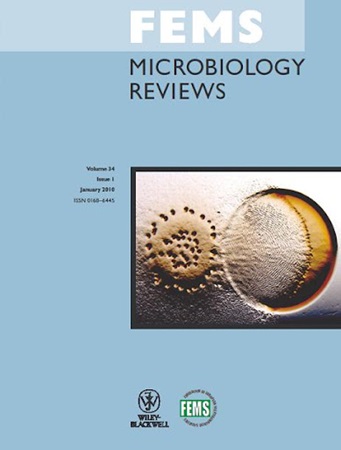压力下的机会性病原体:B 组链球菌如何应对细胞毒性反应物和金属离子失衡条件以求生存
IF 12.3
2区 生物学
Q1 MICROBIOLOGY
引用次数: 0
摘要
B 群链球菌(GBS,又称无乳链球菌)是一种机会性细菌病原体,可导致新生儿、健康或免疫力低下的成年人发生败血症、脑膜炎、肺炎以及皮肤和软组织感染。由于具有大量的毒力机制,GBS 非常适合在人体内生存,这些机制提供了支持细菌在动态宿主环境中生存的反应。这些机制和反应包括抵御因暴露于过量金属离子而导致的细胞死亡(金属离子可导致误杀和细胞毒性),以及抵御活性氧和氮物种等分子的策略,这些分子是宿主先天防御的一部分。活性分子产生的细胞毒性可能源于对蛋白质、DNA 和膜脂的破坏,有可能导致细菌细胞在吞噬细胞内或宿主体内的细胞外空间死亡。破译 GBS 如何应对宿主体内细胞毒性反应分子的压力,将有助于开发新型治疗和预防策略,控制 GBS 疾病的负担。本综述总结了人类携带 GBS 的知识,以及细菌用于规避宿主免疫防御重要因素(氧化应激、亚硝酸应激和金属离子中毒/失活应激)杀灭的机制。本文章由计算机程序翻译,如有差异,请以英文原文为准。
An opportunistic pathogen under stress: how group B streptococcus responds to cytotoxic reactive species and conditions of metal ion imbalance to survive
Group B Streptococcus (GBS; also known as Streptococcus agalactiae) is an opportunistic bacterial pathogen that causes sepsis, meningitis, pneumonia and skin and soft tissue infections in neonates and healthy or immunocompromised adults. GBS is well-adapted to survive in humans due to a plethora of virulence mechanisms that afford responses to support bacterial survival in dynamic host environments. These mechanisms and responses include counteraction of cell death from exposure to excess metal ions that can cause mismetallation and cytotoxicity, and strategies to combat molecules such as reactive oxygen and nitrogen species that are generated as part of innate host defence. Cytotoxicity from reactive molecules can stem from damage to proteins, DNA, and membrane lipids, potentially leading to bacterial cell death inside phagocytic cells or within extracellular spaces within the host. Deciphering the ways in which GBS responds to the stress of cytotoxic reactive molecules within the host will benefit the development of novel therapeutic and preventative strategies to manage the burden of GBS disease. This review summarises knowledge of GBS carriage in humans and the mechanisms used by the bacteria to circumvent killing by these important elements of host immune defence: oxidative stress, nitrosative stress, and stress from metal ion intoxication/mismetallation.
求助全文
通过发布文献求助,成功后即可免费获取论文全文。
去求助
来源期刊

FEMS microbiology reviews
生物-微生物学
CiteScore
17.50
自引率
0.90%
发文量
45
审稿时长
6-12 weeks
期刊介绍:
Title: FEMS Microbiology Reviews
Journal Focus:
Publishes reviews covering all aspects of microbiology not recently surveyed
Reviews topics of current interest
Provides comprehensive, critical, and authoritative coverage
Offers new perspectives and critical, detailed discussions of significant trends
May contain speculative and selective elements
Aimed at both specialists and general readers
Reviews should be framed within the context of general microbiology and biology
Submission Criteria:
Manuscripts should not be unevaluated compilations of literature
Lectures delivered at symposia must review the related field to be acceptable
 求助内容:
求助内容: 应助结果提醒方式:
应助结果提醒方式:


